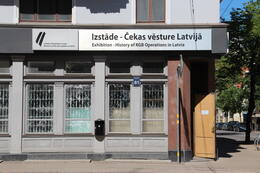Gunars Astra (1931-1988) IV Soviet Occupation
Gunārs Astra (born October 22, 1931 in Riga, died April 6, 1988 in Leningrad) was a Latvian freedom fighter and a prominent Soviet-era dissident. After graduating from the Riga Electromechanical Technical School in 1952, he began working at the VEF factory, where his career as a radio engineer began. In 1958, G. Astra met US diplomats, and this meeting changed his life. In 1961, Gunārs Astra was accused of espionage, treason, and anti-Soviet agitation and propaganda. He was sentenced to 15 years in prison and confiscation of property. Astra served his sentence in the Mordovian ASSR and the Perm region. During his imprisonment, Astra engaged in self-education and met other political prisoners of Latvian and other nationalities. After serving his sentence, Gunārs Astra returned to Latvia. Returning to freedom in 1976, Astra did not renounce his beliefs. In 1983, he was arrested again and tried for possession, reproduction and distribution of “anti-Soviet” literature. As a repeat offender, he was sentenced to seven years in a special regime colony and five years in a settlement. On December 15, 1983, he gave his “Last Word” in court, ending it as follows: “I believe that this time will pass like an evil nightmare. This gives me the strength to stand here and breathe. Our people have suffered a lot and therefore have learned and will also endure this dark time.” Astra served his sentence in the Perm region.
On February 1, 1988, Gunārs Astra was released from custody, but on April 6 of the same year he died in a hospital in Leningrad, possibly poisoned by employees of the USSR State Security Committee.
On April 19, Gunārs Astra was buried in Riga, at the II Mežas Cemetery. Radio Free Europe and Voice of America reported on the funeral and invited everyone to attend. The crowd (about 10 thousand people) filled his grave with their hands.
On October 22, 1991, a monument dedicated to Gunārs Astra was consecrated at the Forest Cemetery, created by artist Raimonds Muzikants and architect Pēteris Štokmanis. In 1993, on the 75th anniversary of the statehood of Latvia, a memorial plaque dedicated to Gunārs Astra was installed in Riga near the Riga Regional Court building at Brīvības Street 34. A street in Riga is named after him.
More information sources
Gunārs Astra. Wikipedia. https://lv.wikipedia.org/wiki/Gun%C4%81rs_Astra
Biruta Eglīte. Who were you, Gunārs Astra? Riga, 1998.
Maris Ruks. Gunars Astra. Riga, 1998.
Trials against Gunārs Astra. Virtual exhibition. Latvian State Archives, 2013.: http://www.archiv.org.lv/astra/
Related objects
Exhibition in the KGB Building "History of KGB Operations in Latvia"
The former USSR State Security Committee (commonly known as Cheka) building is open for visitors. Here chekists imprisoned, interrogated and murdered Latvian citizens who were considered opponents by the occupation regime. There is also an exhibit from the Latvian Occupation Museum on the activities of Cheka in Latvia. Guided tours of the prison cells, corridors, basement and courtyard are available. The house was built in 1911 and it is one of the most beautiful buildings in Riga. Called the ‘Corner House’ by the people, it was the scariest symbol of the Soviet occupation regime in Latvia, and also one of the pillars of power of the USSR. Cheka operated from the Corner House during the occupation from 1940 to 1941 and then again from 1945 to 1991. Tens of thousands of Latvians were affected by direct political persecution. The fight against enemies of Soviet rule continued also after World War II. Cheka’s approach towards its operation slightly changed after Stalin’s death. Physical torture was replaced by psychological terror. The majority of Cheka agents were Latvians (52%). Russians were the second largest group – 23.7%. 60.3% of the agents were not members of the Communist Party. 26.9% of the agents had higher education. The system was designed in a way to involve local people and thus have greater control over the society. Staff documents and service records are located in Russia. And these materials have not been made available to Latvian authorities and researchers.






